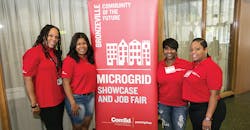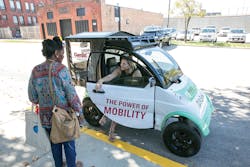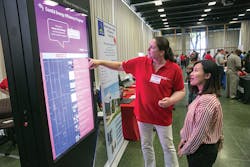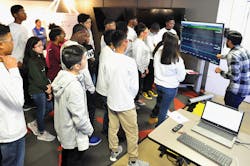ComEd Banks on Innovations to Chart Path to Future
Electric utilities around the world are navigating changing conditions that constitute a new normal. The realities of climate change as well as the increased salience of cybersecurity and physical grid security are placing emphasis on not just the reliability but also the resiliency of the electric system. Additionally, the declining cost of distributed energy resources (DER), like photovoltaics and energy storage, and growing understanding of the need for lower-carbon energy resources means the role utilities play in the lives of customers is changing.
The need to enable customers to consume and produce electricity, while benefiting from a more resilient and sustainable grid, was a catalyst for Commonwealth Edison Co.’s (ComEd’s) efforts to implement smart grid technologies beginning in 2012. The fourth largest electric utility in the United States, with 4 million customers in northern Illinois, ComEd now is leveraging its stronger and more reliable smart grid to introduce a wide range of innovations, so it can meet the growing customer choice and service expectations in the current digital age.
Bringing these customer choice and service innovations requires many partnerships. On the Near South Side of Chicago, Illinois, ComEd is collaborating with stakeholders—including civic organizations, academic institutions, and local businesses—to develop and demonstrate technologies and programs that will make the neighborhood of Bronzeville a Community of the Future. This area not only is a living laboratory that enables the utility to demonstrate technologies before scaling them across its service territory but also represents a compact between the utility and neighborhood to identify programs that serve specific needs as well as support the goals and aspirations of the community.
Electrified Mobility
This Community of the Future is being implemented to be a resilient, economical and sustainable community where customers can fully leverage the promise of these technologies to address pressing community priorities and challenges. Programming is provided to local stakeholders to demonstrate the value of the technologies. For example, educational offerings help a new generation of students gain an edge in the science, technology, engineering and math (STEM) fields as well as qualify for related career opportunities through engagement with the underlying technologies operating in their community, such as microprocessors.
For ComEd the dual focus of showcasing technology and creating opportunities for engagement is foundational to its long-term vision of creating connected communities. In essence, ComEd is offering smart-city solutions that link technology with programs demonstrating the possibilities. For each of the solutions, the utility is deeply committed to engaging community stakeholders by using their input to make decisions about which technologies are most needed and where and how to deploy them for maximum effect.
For example, addressing micro transit challenges is one of the most important components of smart communities. Electric vehicles (EVs) offer a terrific opportunity to limit the environmental impact of travel. However, many urban residents, particularly those living in multiunit dwellings, lack access to the technology. Therefore, ComEd has launched a DASH EV pilot with Innova EV, which offers an EV mobility program to residents of three senior citizen centers in Bronzeville, giving them an opportunity to use and understand how this technology can enhance their lives.
As part of a grant from the U.S. Department of Energy, ComEd also will be working with local stakeholders to identify a location for additional EV charging stations in Bronzeville to serve those living in multiunit dwellings or for roadside charging. In addition, ComEd is partnering with Virginia Polytechnic Institute and State University on a second grant from the Department of Energy to develop and install an extremely fast-charging (XFC) EV charging station, which will be placed within the Bronzeville community microgrid.
Powering the Smart Grid
Electric vehicles are just one important technology. To power these vehicles, there is a need for increased generation, ideally low-carbon generation. ComEd is developing a technology as part of the Sustainable and Holistic Integration of Energy Storage and Solar (SHINES) photovoltaics (PV) project, supported by a third grant from the Department of Energy. The project will demonstrate the optimal usage of PV and energy storage within a microgrid.
Simultaneously, the utility is partnering with Aris Wind LLC to install five off-grid outdoor security lighting units, each of which will be powered by a wind turbine, solar panel and battery. To ensure they are located where they can provide maximum value, ComEd worked with local stakeholders to identify two public schools in areas that also are on safe passage routes, so the lighting technology can serve the dual purpose of enhancing security while also demonstrating the value of renewable generation.
To leverage the benefits of large amounts of PV, the smart grid must leverage sensors that provide system operators the data needed to make good decisions. ComEd is working with Array of Things to install solar sensors that will provide additional information regarding solar irradiation, which will support efforts to do load forecasting. Array of Things is a collaborative effort among scientists, universities, local government and communities to collect real-time data on urban environment, infrastructure, and activity for research and public use.These same sensors also can measure local air quality, which will help community stakeholders and responsible government officials to identify where efforts are needed to mitigate the effects of pollution.
To make the sensors function, a communications infrastructure is necessary. ComEd is exploring how fiber-optic cable can provide the additional capability needed to collect and analyze the data it needs in a timely fashion to integrate additional intermittent generation like PV and improve cybersecurity. In Bronzeville, ComEd also is demonstrating how that same fiber can be used to support IKE Smart City kiosks that provide the community with way-finding and public service information as well as public Wi-Fi services.
Role of Education
Maybe the most exciting demonstration of how fiber-optic cable can support electric utilities is its role in the Bronzeville community. This project, which will be the first utility-operated microgrid cluster, not only provides significant resiliency benefits to the more than 700 customers being served by it, as well as neighboring areas, but also demonstrates technological innovation and helps support the development of technical skills within the community. Much of that innovation relies on technologies enabled by the data provided by the fiber-optic cable.
This innovation will produce real economic impact. ComEd sponsored a Bronzeville microgrid showcase and job fair to provide technical information about the projects to members of the community and gave them an opportunity to learn about and apply for more than 200 jobs related to the microgrid and other energy jobs. This is essential because these new technologies being demonstrated in the Community of the Future require a trained workforce to deploy and operate them.
Some of these workforce needs are immediate, but there also is a longer-term obligation to develop the engineering capacity to design and implement these technologies and the next generation of innovations.
Broadly speaking, educational justice is the foundation of a sustainable community, and these innovations will have the most impact when developed by those who will use them. For this reason, ComEd launched its first ever Ideathon in December 2017. It partnered high school students from Bronzeville with local engineers to develop innovations that leverage the smart grid capability for smart city solutions.
In addition, ComEd is partnering with Dunbar High School to develop a curriculum for an energy academy that would prepare students for careers in the new energy economy. The utility also is partnering with the HFS Chicago Scholars program to develop and implement an innovative STEM learning challenge. It links economically disadvantaged students with local engineers, advanced technologies and ComEd senior leadership, so the students can understand how energy technologies truly are made.
New Demands
Individually, each of these programs and technologies represent significant innovations. However, put them all together and they represent the broader vision of how an electric utility can lead the way into the future. This new normal demands new ideas, both technologically and programmatically, from electric utilities and the communities they serve. In Bronzeville, ComEd is showing how the Community of the Future is deeply intertwined with the Utility of the Future.
About the Author
Shay Bahramirad
Shay Bahramirad is the vice president of Engineering and Smart Grid at ComEd, where she serves as a strategic business leader in Commonwealth Edison, the electric utility serving Northern Illinois including Chicago, holding executive responsibility for ComEd’s vision of the grid of the future as well as communities of the future, system reliability, engineering, and planning. She completed her PhD in electrical engineering at the Illinois Institute of Technology.
Sandor D. Williams
Sandor D. Williams ([email protected]) is a manager of Smart Grid and Technology at Commonwealth Edison. He is responsible for managing ComEd’s Smart Grid programs group, development of business cases and business transformation efforts supporting implementation of new technologies, and guiding ComEd’s Community of the Future program initiative. He holds an M.B.A. from Roosevelt University and a bachelor’s degree in civil engineering from Southern Illinois University.
Daniel Kushner
Daniel Kushner is Director of Resiliency Strategy at LUMA Energy. He holds a bachelor's degree in history from Johns Hopkins University and a PhD in political science from Brown University.



